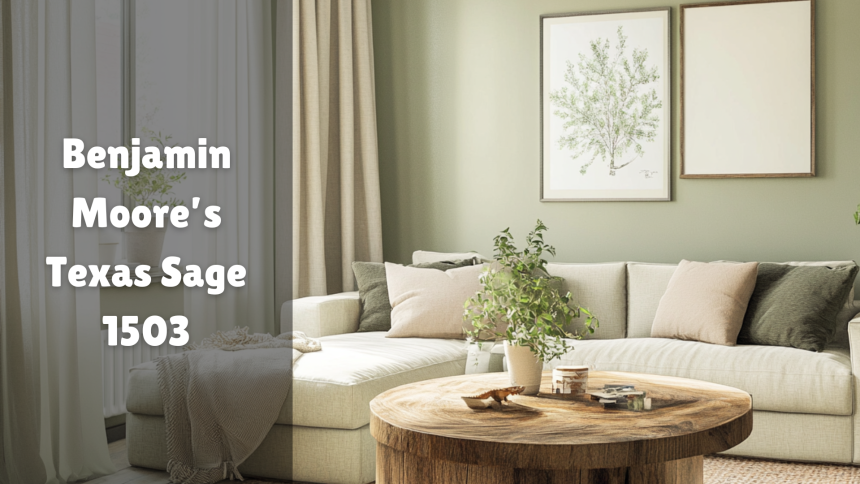Ever noticed how some rooms just make you feel good the moment you walk in? The secret might be on the walls. Texas Sage 1503 isn’t just another paint color – it’s the answer many homeowners have been looking for.
Picking the right color can be tough. Too bright feels harsh, too dark feels heavy, and the wrong tone can clash with everything else in your home. When your walls don’t look right, your whole space feels off.
Texas Sage offers the perfect middle ground – a soft green-gray that brings calm to any room without being dull. It works with most home styles, from modern to traditional, and plays well with whites, woods, and other colors.
Think of it as the friendly neighbor who gets along with everyone. Ready to see how this color could change your home? Let’s get started.
Color Characteristics of Texas Sage
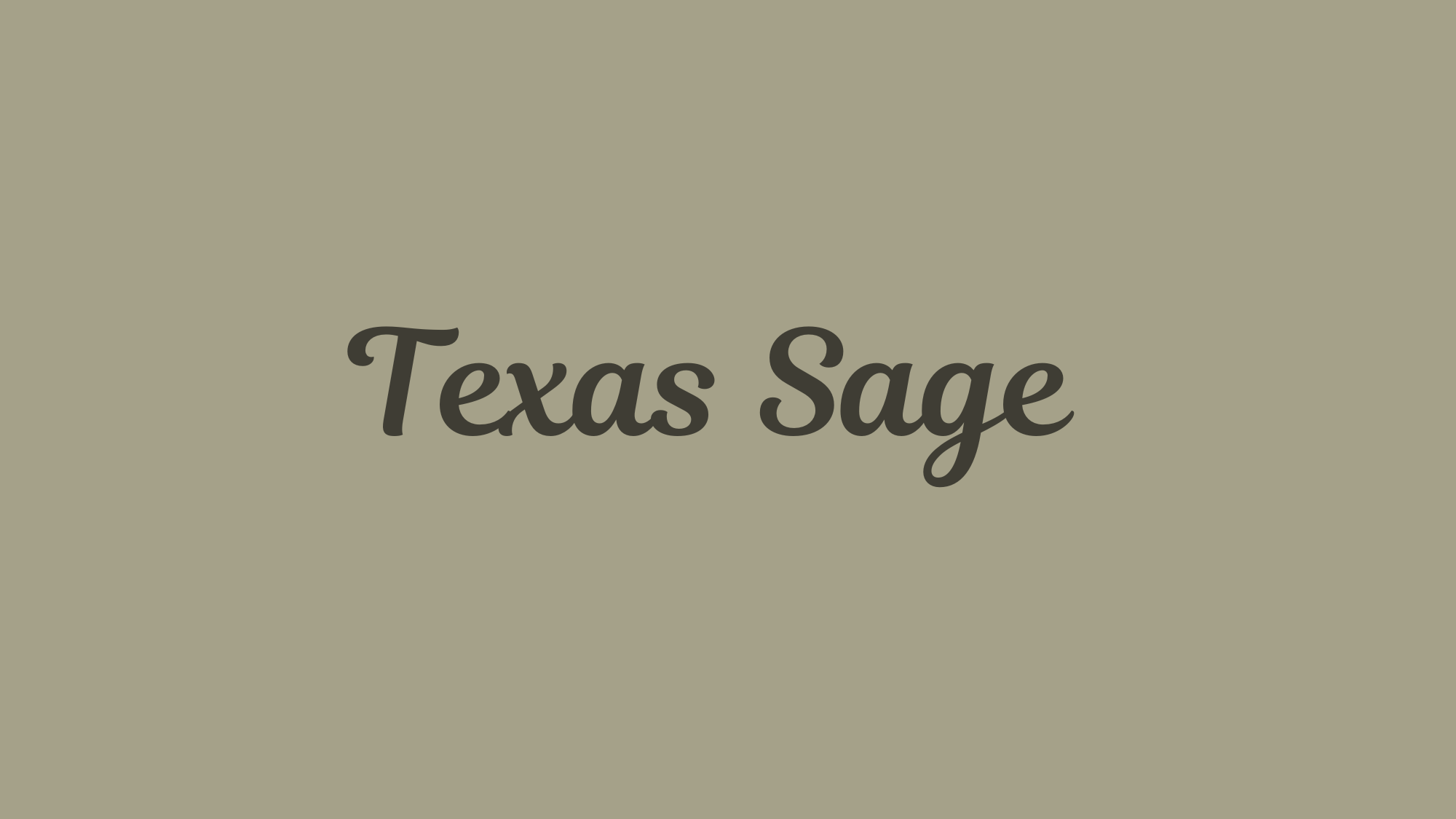
Texas Sage 1503 by Benjamin Moore is a soft, muted green with a gentle, earthy tone. With its subtle blend of green and gray, this color evokes a tranquil and grounded atmosphere, making it a versatile choice for any home.
It’s part of Benjamin Moore’s extensive palette, offering a unique and understated hue to enhance various interior designs. Here are some of it’s basic details:
| Characteristic | Description |
|---|---|
| Color Code | 1503 |
| Undertones | Soft blend of sage green and gentle gray |
| Also Known As | CC-602, TH-200 |
| Light Reflection Value (LRV) | Approximately 34.21, offering a medium-depth appearance |
| Mood | Calming and grounding |
| Best Rooms | Living rooms, bedrooms, home offices, and bathrooms |
| Color Family | Green-Gray |
| Finish Recommended | Matte or Eggshell |
Texas Sage 1503 offers not just a color but a mood for your home, bringing the calm of nature indoors while maintaining enough neutrality to work with your existing decor.
Detailed Analysis of Benjamin Moore’s Texas Sage 1503
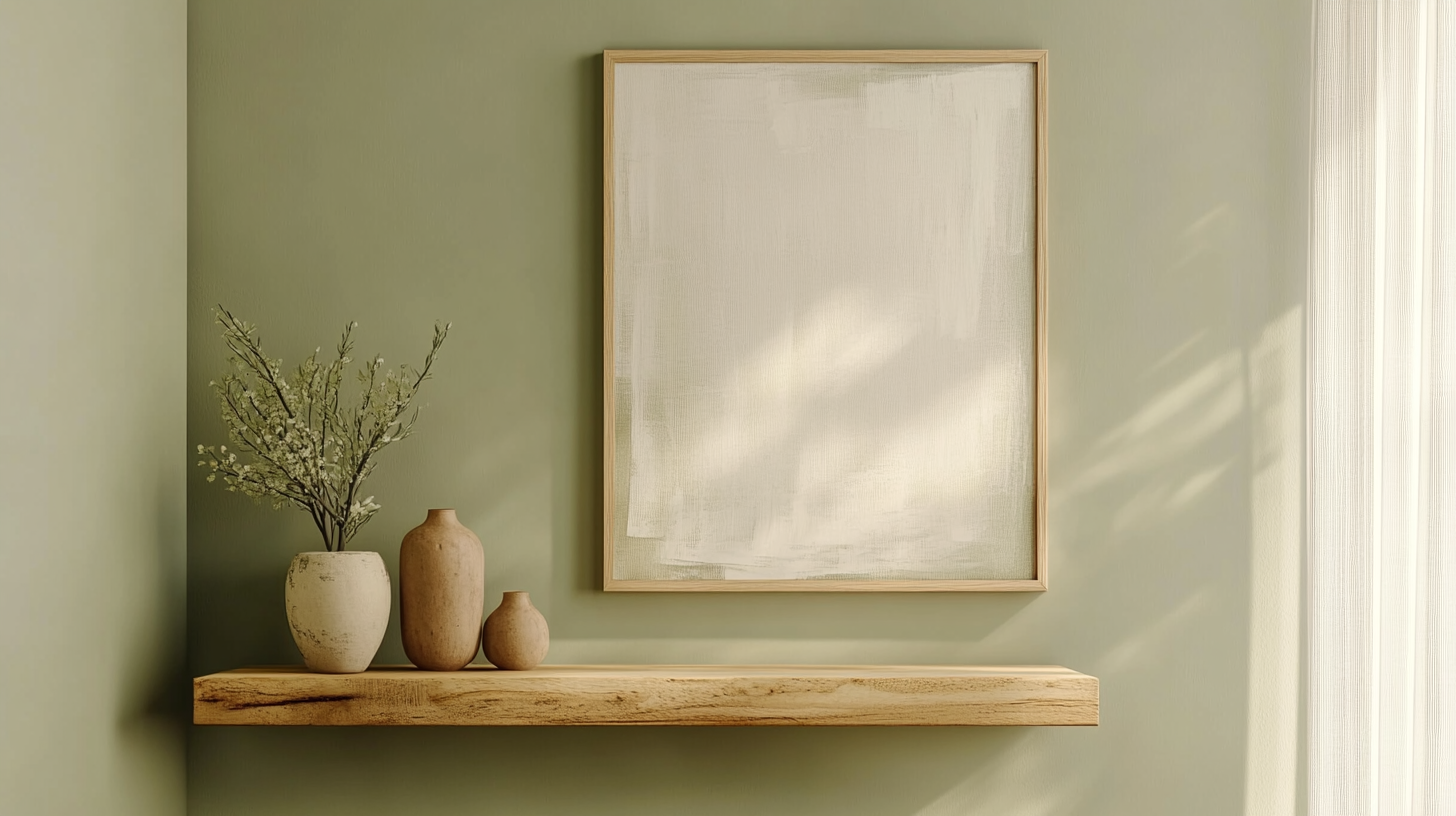
Now, let’s dive deeper into how Texas Sage 1503 performs in different areas, from its stain resistance and ease of maintenance to its versatility in various lighting conditions.
By understanding its strengths and limitations, you’ll be better equipped to decide how to incorporate this beautiful color into your home.
1. Stain Resistance and Cleanability
The stain resistance and ease of cleaning for Texas Sage 1503 are influenced by the chosen finish.
Flat and satin finishes offer a visually appealing look; however, they are more prone to staining, necessitating more regular cleaning.
In contrast, semi-gloss and high-gloss finishes offer enhanced stain resistance and are easier to clean, making them more suitable for areas prone to spills and high activity.
- Pros: Higher-sheen finishes facilitate easier maintenance and are more resistant to stains, ensuring longevity and sustained visual appeal.
- Cons: Matte finishes may require more upkeep to maintain their appearance, especially in high-traffic areas.
2. Paint Coverage and Application
Benjamin Moore’s paints, including the Regal Select line, are renowned for their excellent coverage and ease of application.
Typically, one gallon covers approximately 300-400 square feet, depending on surface texture and porosity.
Application methods encompass brush, roller, or spray, with drying times around one hour and recoat times of four hours under standard conditions.
- Pros: The paint’s superior coverage reduces the need for multiple coats, streamlining the painting process and potentially lowering project costs.
- Cons: Application in extreme temperatures or humidity levels may affect drying times and overall finish quality.
3. VOC Content and Environmental Factors
Benjamin Moore is committed to developing environmentally responsible products.
Many of their paints, including those in the Regal Select line, have low to zero volatile organic compound (VOC) content, contributing to improved indoor air quality.
This formulation reduce harmful emissions indoors, promoting a healthier living environment.
- Pros: Low-VOC formulations minimize harmful emissions, promoting a healthier living environment and aligning with sustainable building practices.
- Cons: However, they can sometimes have longer drying times compared to traditional paints due to their reduced chemical content.
4. Trend Factor
Muted and earthy tones like Texas Sage 1503 have gained popularity in contemporary design due to their versatility and ability to create calming environments.
While trends may evolve, this color’s classic appeal ensures its relevance across various design appeal.
- Pros: The color’s enduring nature allows it to complement both current and future design trends, providing lasting value.
- Cons: Those seeking more avant-garde or transient design elements might find the color too conventional.
5. Drying Time and Touch-Up
Under standard conditions, Texas Sage 1503 exhibits a touch-dry time of up to one hour and a recoat time of up to one hour, facilitating efficient project timelines.
The paint’s excellent touch-up capabilities ensure that minor repairs blend seamlessly with the existing surface.
- Pros: Quick drying and recoat times expedite project completion, and the paint’s touch-up compatibility simplifies maintenance.
- Cons: Rapid drying may pose challenges in achieving a uniform finish, especially in larger areas without adequate ventilation.
6. Attractive Appeal in Different Lighting
Texas Sage 1503 adapts beautifully to different lighting conditions. In natural light, its olive green tones stand out, creating a warm, inviting atmosphere.
Under artificial lighting, its gray undertones become more visible, offering a subdued, sophisticated look. This ability to shift with lighting makes it a versatile color for various rooms and setups.
- Pros: The color’s flexibility in different lighting conditions enhances its versatility, making it suitable for diverse environments.
- Cons: In spaces with limited natural light, it may appear darker and less vibrant, affecting the room’s ambiance.
Texas Sage 1503 Final Look Inspirations
Texas Sage’s calming, sophisticated green with a soft, muted undertone can bring natural warmth to any interior. Its balanced tone creates serene spaces that feel inviting and grounded, effortlessly blending with a variety of styles.
Let’s Look at some of the final look inspirations in interior designs:
1. Living Room
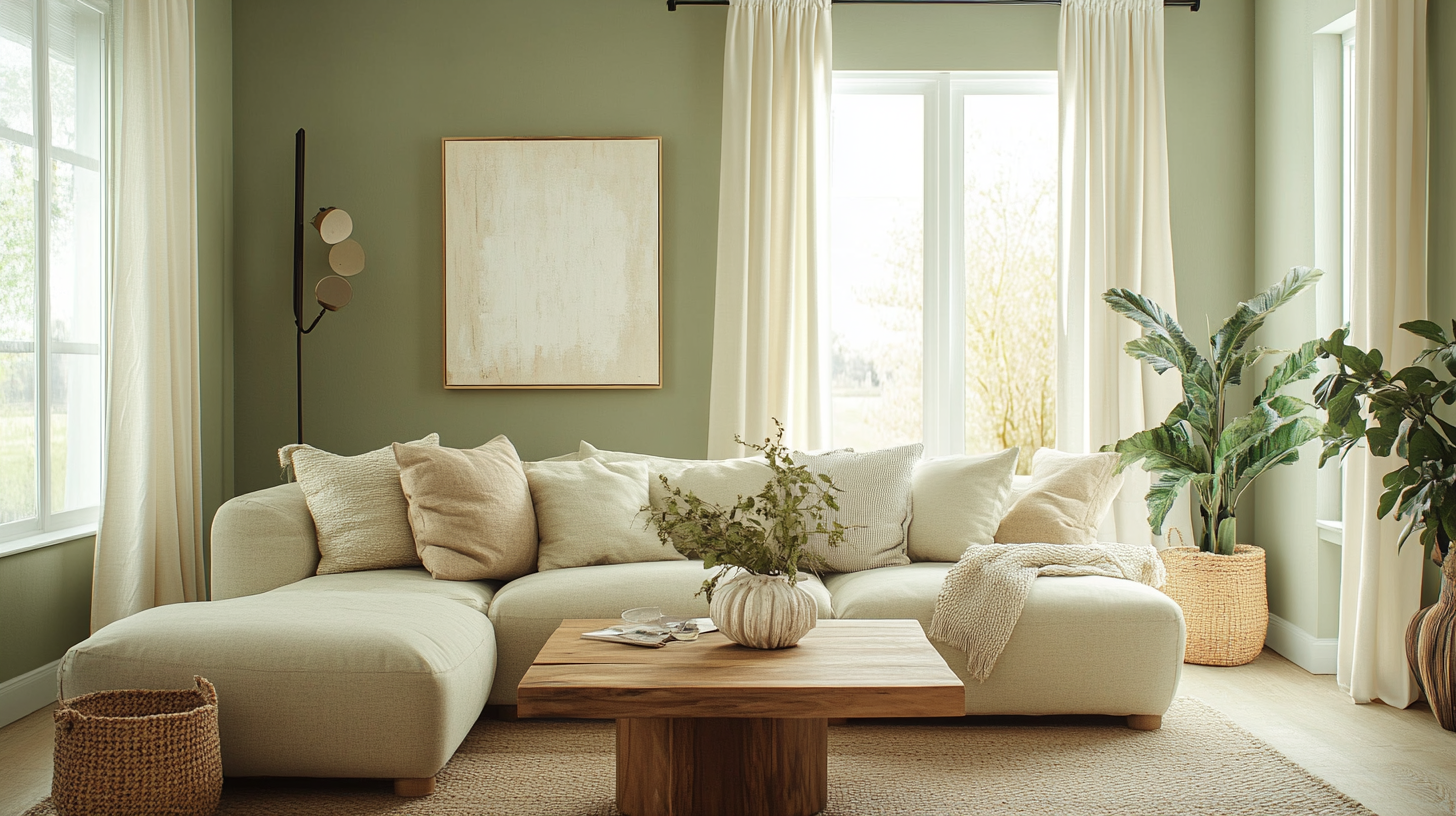
Benjamin Moore’s Texas Sage 1503 brings warmth and comfort to the living room with its muted olive-green tones. The soft, earthy hue creates a cozy and inviting atmosphere, perfect for unwinding after a long day.
Its grounding qualities, paired with natural wood accents, bring a harmonious balance to the space.
The color also pairs well with neutral tones, providing a calm and tranquil environment that encourages relaxation and socializing.
2. Bedroom
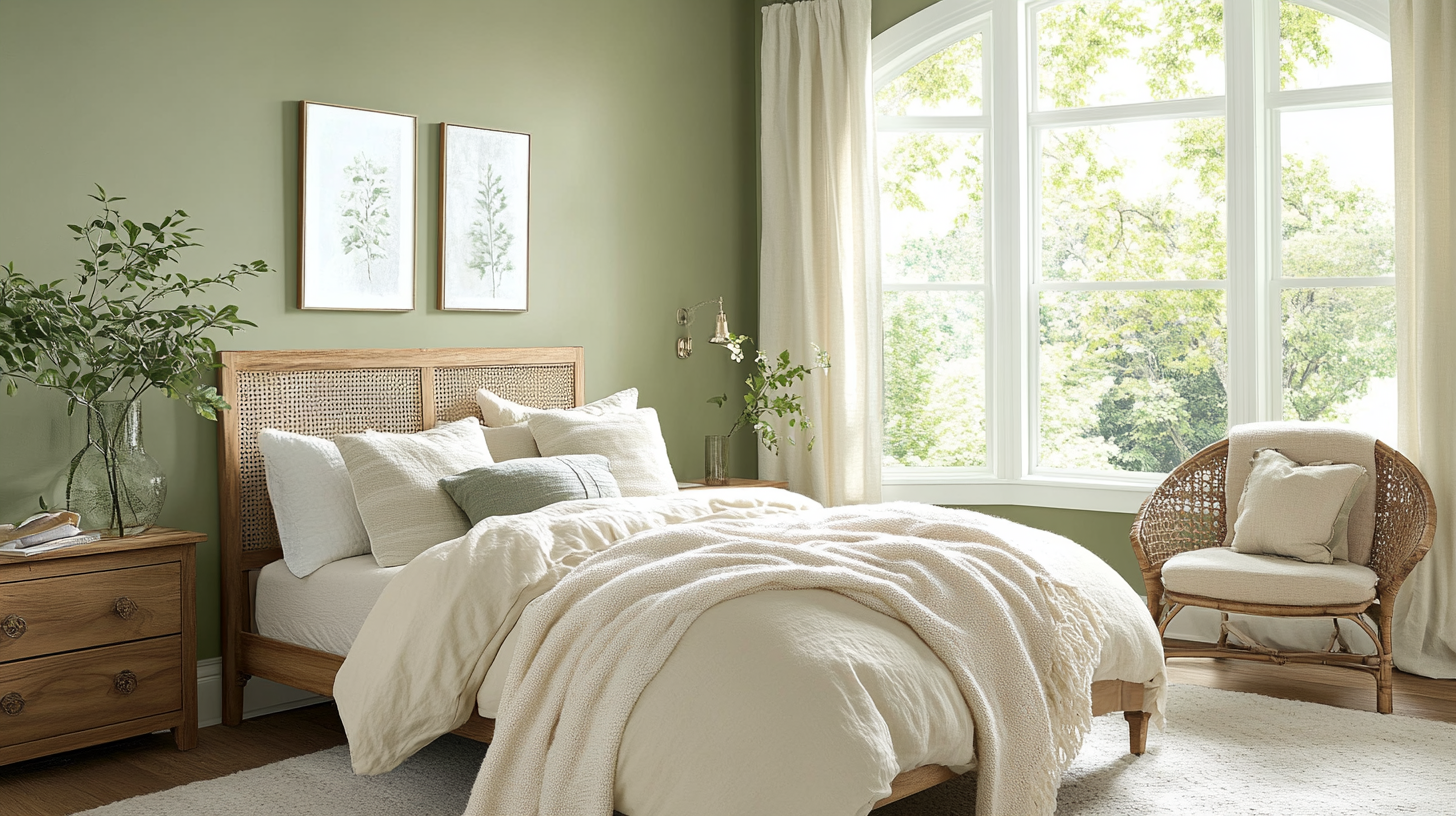
Texas Sage 1503 enhances the bedroom’s peaceful and serene atmosphere with its soft, subtle hue. The color’s muted tones evoke a sense of calm, making it an ideal choice for a restful retreat.
It complements both light and dark furniture pieces, helping to create a spacious and balanced look.
The psychological effect of green in this room promotes relaxation and mental clarity, contributing to a restful night’s sleep.
3. Dining Area

In the dining area, Texas Sage 1503 introduces a refined, earthy appeal that enhances the atmosphere without overwhelming the space. The color creates a natural, inviting feel that complements wood or stone cabinetry beautifully.
This green shade helps establish visual continuity, especially when paired with plants or other natural elements, promoting a sense of connection with nature.
It fosters a welcoming environment for gatherings and meals, adding sophistication while maintaining a grounded, earthy vibe.
4. Bathroom
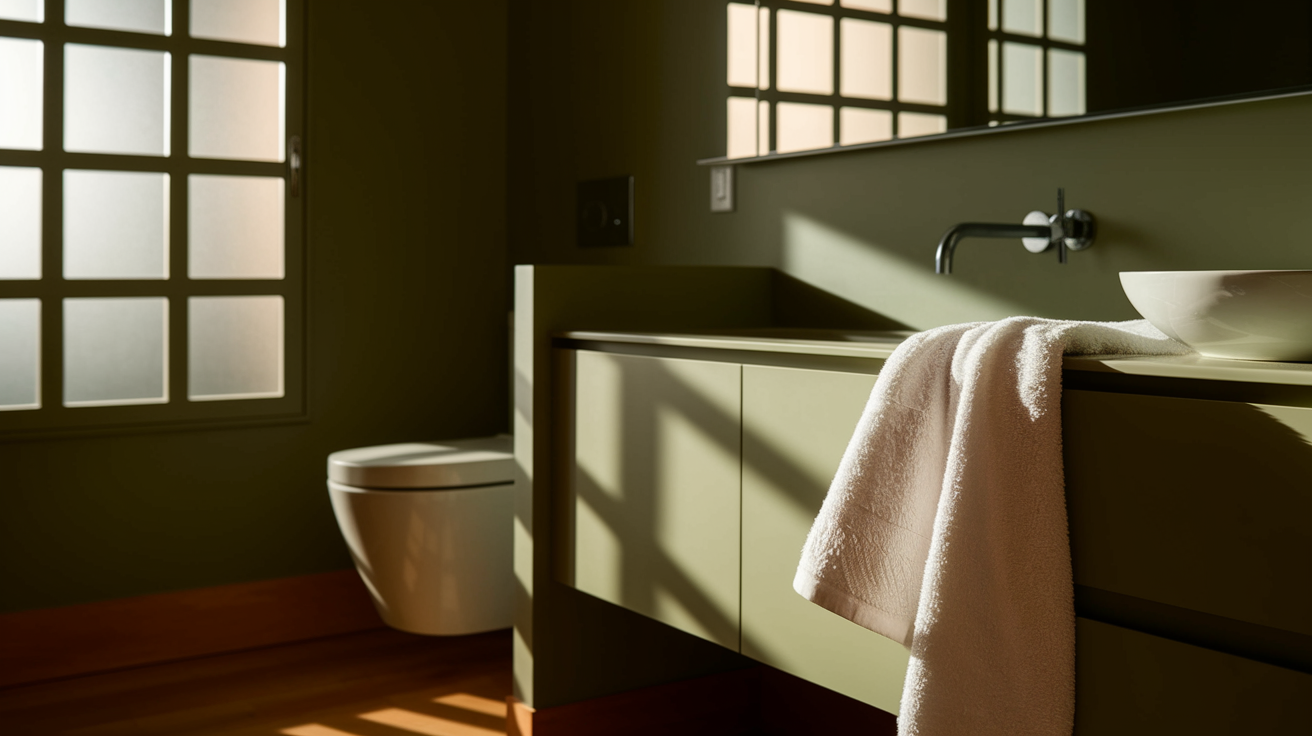
In the bathroom, Texas Sage 1503 transforms the space into a spa-like retreat. The soft, tranquil hue enhances the feeling of relaxation and calm, ideal for a space meant for rejuvenation.
The green tones work seamlessly with cool-toned fixtures, natural materials, and stone, creating a balanced, harmonious environment.
The color’s ability to maintain a fresh, serene appearance in high-moisture environments further enhances its suitability for the bathroom, promoting a sense of cleanliness and tranquility.
5. Kitchen

In the kitchen, Texas Sage 1503 adds a natural, calming backdrop that contrasts well with the usual bustling activity of the space. Its earthy tones balance the vibrancy often found in kitchens, creating a peaceful yet energizing environment.
The color complements stainless steel, wood, and stone finishes, helping to tie together the various elements of the kitchen.
|
Note: Before fully applying Texas Sage 1503 to your walls, it’s recommended to perform a patch test. Apply a small amount of paint on a hidden section of the wall to see how it interacts with your surface and lighting. This will help you ensure the color looks just as you imagined and blends well with your space. |
Different Shades of Texas sage 1503
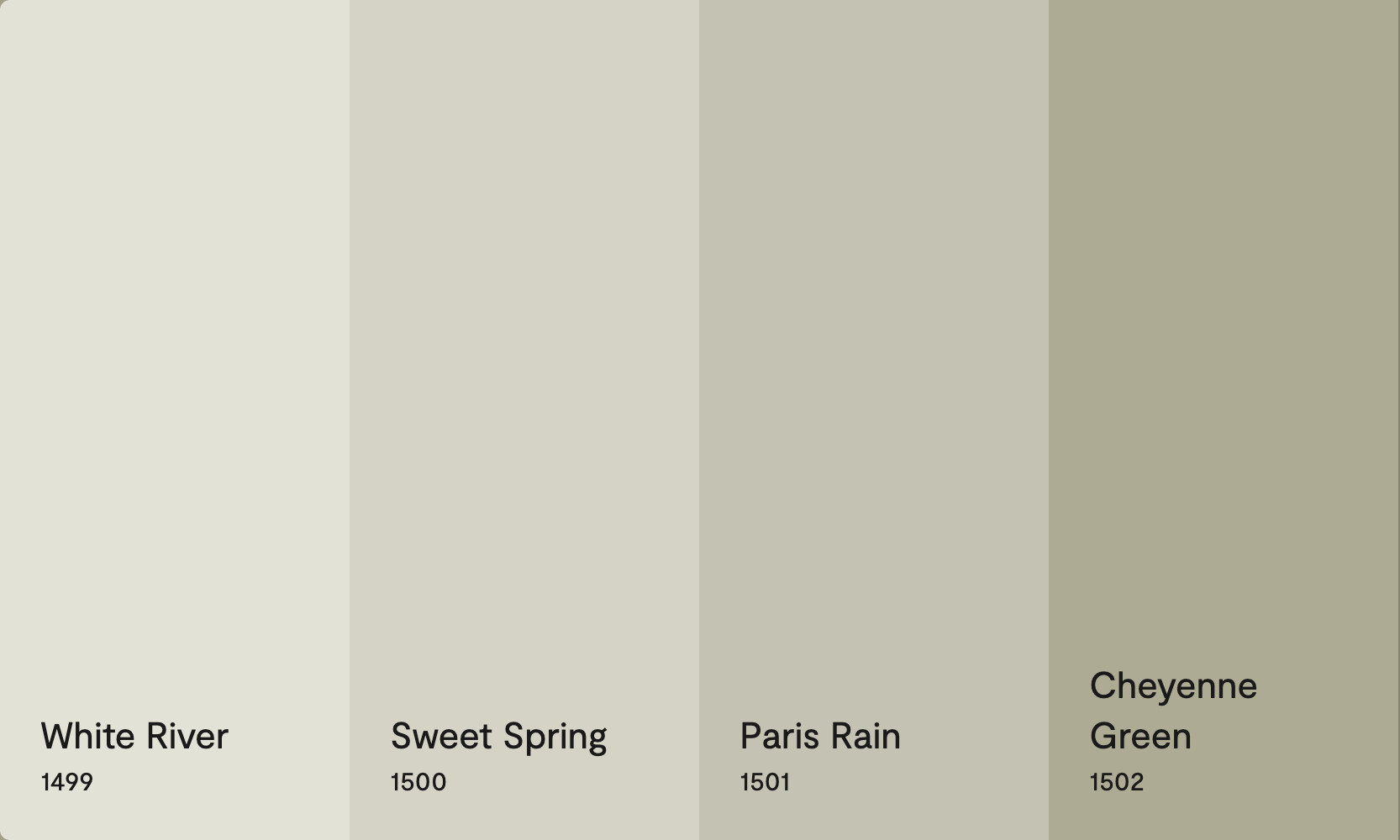
If you like Texas Sage 1503 but want to see similar options in the same color family, Benjamin Moore offers several related shades that share its calm, natural appeal while varying slightly in depth and tone.
White River 1499: A soft, pale green with subtle gray undertones, creating a light and airy atmosphere while still maintaining a grounded feel.
Sweet Spring 1500: A fresh, muted green with a touch of blue, bringing a cool and serene vibe to any room.
Paris Rain 1501: A sophisticated, muted green with a soft, silvery finish that evokes a calm, refined ambiance.
Cheyenne Green 1502: A rich, earthy green with brown undertones, offering a deep, natural look that brings warmth and comfort to a space.
Some Beautiful Color scheme Ideas with Texas Sage 1503
Benjamin Moore Texas Sage 1503 is a soft, earthy green with a subtle muted undertone that brings a warm, natural touch to any space.
It’s a versatile color that works well with various design styles, from modern minimalism to rustic charm. Below are some color schemes that incorporate Texas Sage, offering cohesive and balanced looks for every room.
1. Monochromatic Scheme
A monochromatic scheme uses various shades of Texas Sage to create a cohesive and serene look. It brings depth and tranquility to any space.
Recommended paints:
2. Warm Color Scheme
Pairing Texas Sage with warm tones creates a welcoming, cozy atmosphere, perfect for living spaces that need a grounded, energetic feel.
Recommended paints:
3. Cool Color Scheme
Cool tones like blues and grays paired with Texas Sage create a calming, tranquil environment, ideal for bedrooms or bathrooms.
Recommended paints:
- Pale Smoke (Benjamin Moore 1584
- Blue Lake (Benjamin Moore 2053-40
- Smoke (Benjamin Moore 2122-40)
- Silver Gray (Benjamin Moore 2131-60)
Conclusion: The Classic Appeal of Texas Sage
As you consider your next painting project, think about what Texas Sage brings to your home – a sense of peace and balance that few colors can match.
What makes Texas Sage special is how it shifts with the light throughout the day, giving your rooms fresh looks from morning to evening.
It’s a color that grows with you, fitting well with changing styles and seasons. If it’s in your living room, bedroom, or kitchen, Texas Sage offers that rare mix of being both current and lasting.
It works beautifully with whites, woods, and metals, making it easy to match with your existing furniture.
When you choose Texas Sage, you’re not just picking a paint color – you’re creating an atmosphere. It’s a choice that turns your house into a true haven, a place where memories are made and life feels good.

